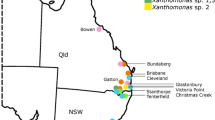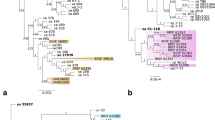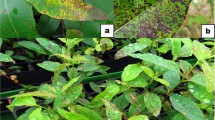Abstract
Bacterial spot of tomato (BST) is a major constraint to tomato production in Ethiopia and many other countries leading to significant crop losses. In the present study, using pathogenicity tests, sensitivity to copper and streptomycin, and multilocus sequence analysis (MLSA), we identified a diverse group of Xanthomonas strains isolated from central Ethiopia. None of the strains were sensitive to copper or streptomycin. Multilocus sequence analysis was used to compare Ethiopian strains with representative Xanthomonas strains from a worldwide collection based on DNA sequences of six housekeeping genes (lacF, lepA, gyrB, fusA, gltA and gapA) and hrpB genes. Phylogenetic analysis of the concatenated sequences showed that X. gardneri, X. vesicatoria and X. perforans were associated with BST in Ethiopia, whereas Xanthomonas euvesicatoria was absent from the Ethiopian sample. There was no genetic diversity among the isolated strains belonging to X. gardneri and X. perforans. However, two X. vesicatoria haplotypes were identified indicating at least two different sources of introduction of X. vesicatoria to Ethiopia. All of the X. perforans strains were only pathogenic on tomato and were T3 strains with the exception of one identified as tomato race 4 (T4). The X. gardneri and X. vesicatoria strains were tomato race 2 (T2), but were variable in pepper race determinations indicating variation in effectors among strains.



Similar content being viewed by others
References
Almeida, N. F., Shuangchun, Y., Magdalen, L., David, J. S., David, J. S., Bradford, C., Haijie, L., Carlos, J. V., Andrew, W., Clive, E., Eric, K., Dan, M., Aurelie, A., Gregory, B. M., Jonathan, D. J., Alan, C., Joao, C. S., & Boris, A. V. (2009). Draft Genome Sequence of Pseudomonas syringae pv. tomato, T1 Reveals a Type III Effector Repertoire Significantly Divergent from That of Pseudomonas syringae pv. tomato DC3000. Molecular Plant Microbe Interactions, 22(1), 52–62.
Almeida, N. F., Yan, S., Cai, R., Clarke, C. R., Morris, C. E., Schaad, N. W., Schuenzel, E. L., Lacy, G. H., Sun, X., Jones, J. B., Castillo, J. A., Bull, C. T., Leman, S., Guttman, D. S., Setubal, J. C., & Vinatzer, B. A. (2010). PAMDB, A multilocus sequence typing and analysis database and website for plant-associated microbes. Phytopathology, 100(208), 215.
Araújo, E. R., Pereira, R. C., Ferreira, M. A. S. V., Quezado-Duval, A. M., & Café-Filho, A. C. (2012). Sensitivity of xanthomonads causing tomato bacterial spot to copper and streptomycin and in vivo infra-specific competitive ability in Xanthomonas perforans resistant and sensitive to copper. Journal of Plant Pathology, 94, 79–87.
Ausubel, F. M., Brent, R., Kingston, R. E., Moore, D. D., Seidman, J. G., Smith, J. A., & Struhl, K. (1994). Current protocols in molecular biology. New York: John Wiley and Sons.
Behlau, F., Hong, J. C., Jones, J. B., & Graham, J. H. (2013). Evidence for acquisition of copper resistance genes from different sources in citrus-associated xanthomonads. Phytopathology, 103, 409–418.
Bouzar, H., Ahmed, N. E., Somodi, G. C., Jones, J. B., & Stall, R. E. (1994a). Characterization of Xanthomonas campestris pv.vesicatoria strains from tomato and pepper grown in Sudan. Plant Disease, 78, 12–19.
Bouzar, H., Jones, J. B., Stall, R. E., Hodge, N. C., & Minsavage, G. V. (1994b). Physiological, chemical, serological, and pathogenic analyses of a worldwide collection of Xanthomonas campestris pv. vesicatoria strains. Phytopathology, 84, 663–671.
Bouzar, H., Jones, J. B., Somodi, G. C., Stall, R. E., Daouzli, N., Lambe, R. C., Felix, G. R., & Trinidad-Correa, R. (1996). Xanthomonas campestris pv. vesicatoria race variation in tomato and pepper fields of Mexico. Canadian Journal of Plant Pathology, 18, 75–77.
Bouzar, H., Jones, J. B., Stall, R. E., Louws, F. J., Schneider, M., Rademaker, J. L. W., de Bruijn, F. J., & Jackson, L. E. (1999). Multiphasic analysis of xanthomonads causing bacterial spot disease on tomato and pepper in the Caribbean and Central America: evidence for common lineages within and between countries. Phytopathology, 89, 328–335.
Bradbury, J. F. (1970). Isolation and preliminary study of bacteria from plants. Review of Plant Pathology, 49(213), 218.
Edgar, R. C. (2004). MUSCLE: multiple sequence alignment with high accuracy and high throughput. Nucleic Acids Research, 32(1792), 1797.
Hamza, A. A., Robène-Soustrade, I., Jouen, E., Gagnevin, L., Lefeuvre, P., Chiroleu, F., & Pruvost, O. (2010). Genetic and pathological diversity among Xanthomonas strains responsible for bacterial spot on tomato and pepper in the southwest Indian Ocean region. Plant Disease, 94(993), 999.
Hert, A. P., Roberts, P. D., Momol, M. T., Minsavage, G. V., Tudor-Nelson, S. M., & Jones, J. B. (2005). Relative importance of bacteriocin-like genes in antagonism of Xanthomonas perforans tomato race 3 to Xanthomonas euvesicatoria tomato race 1 strains 259. Applied and Environmental Microbiology, 71, 3581–3588.
Horvath, D. M., Stall, R. E., Jones, J. B., Pauly, M. H., Vallad, G. E., Dahlbeck, D., Staskawicz, B. J., & Scott, J. W. (2012). Transgenic resistance confers effective field level control of bacterial spot disease in tomato. PloS One, 7(8), e42036. doi:10.1371/journal.pone.0042036.
Jones, J. B., Pohronezny, K. L., Stall, R. E., & Jones, J. P. (1986). Survival of Xanthomonas campestris pv. vesicatoria in Florida on tomato crop residues, weeds, seeds and volunteer tomato plants. Phytopathology, 76, 430–434.
Jones, J. B., Stall, R. E., Scott, J. W., Somodi, G. C., Bouzar, H., & Hodge, N. C. (1995). A third tomato race of Xanthomonas campestris pv.vesicatoria. Plant Disease, 79, 395–398.
Jones, J. B., Bouzar, H., Somodi, G. C., Stall, R. E., Pernezny, K., El-Morsy, G., & Scott, J. W. (1998a). Evidence for the preemptive nature of tomato race 3 of Xanthomonas campestris pv. vesicatoria in Florida. Phytopathology, 88, 33–38.
Jones, J. B., Stall, R. E., & Bouzar, H. (1998b). Diversity among xanthomonads pathogenic on pepper and tomato. Annual Review of Phytopathology, 36(41), 58.
Jones, J. B., Bouzar, H., Stall, R. E., Almiram, E. C., Roberts, P. D., Bowen, B. W., Sudberry, J., Strickler, P. M., & Chun, J. (2000). Systematic analysis of xanthomonads (Xanthomonas spp.) associated with pepper and tomato lesions. International Journal of Systemic and Evolution Microbiology, 50, 1211–1219.
Jones, J. B., Lacy, G. H., Bouzar, H., Stall, R. E., & Schaad, N. W. (2004). Reclassification of the Xanthomonads associated with bacterial spot disease of tomato and pepper. Systematic and Applied Microbiology, 27(755), 762.
Jones, J. B., Zitter, T. A., Momol, T. M., & Miller, S. A. (2013). Compendium of tomato diseases and pests (2nd ed.). St. Paul: APS Press.
Keen, N. T., Dahlbeck, D., Staskwicz, B., & Belser, W. (1984). Molecular cloning of pectate lyase genes from Erwinia chrysanthemi and their expression in Escherichia coli. Journal of Bacteriology, 159, 825–831.
Maiden, M. C. (2006). Multilocus sequence typing of bacteria. Annual Review of Microbiology, 60(561), 588.
Maiden, M. C., Bygraves, J. A., Feil, E., Morelli, G., Russell, J. E., Urwin, R., Zhang, Q., Zhou, J., Zurth, K., Caugant, D. A., Feavers, I. M., Achtman, M., & Spratt, B. G. (1998). Multilocus sequence typing: a portable approach to the identification of clones within populations of pathogenic microorganisms. Proceedings of the National Academy of Sciences, 95, 3140–3145.
Mbega, E. R., Mabagala, R. B., Adriko, J., Lund, O. S., Wulff, E. G., & Mortensen, C. N. (2012). Five species of xanthomonads associated with bacterial leaf spot symptoms in tomato from Tanzania. Plant Disease, 96, 760.
Obradovic, A., Mavridis, A., Rudolph, K., Janse, J. D., Arsenijevic, M., Jones, J. B., Minsavage, G. V., & JawFen, W. (2004). Characterization and PCR-based typing of Xanthomonas campestris pv. vesicatoria from peppers and tomatoes in Serbia. European Journal of Plant Pathology, 110, 285–292.
OEPP/EPPO. (1988). Data sheets on quarantine organisms No. 157, Xanthomonas campestris pv. vesicatoria. OEPP/EPPO Bulletin, 18, 521–526.
Parkinson, N., Aritua, V., Heeney, J., Cowie, C., Bew, J., & Stead, D. (2007). Phylogenetic analysis of Xanthomonas species by comparison of partial gyrase B gene sequences. International Journal of Systemic and Evolution Microbiology, 57(2881), 2887.
Parkinson, N., Cowie, C., Heeney, J., & Stead, D. (2009). Phylogenetic structure of Xanthomonas determined by comparison of gyrB sequences. International Journal of Systemic and Evolution Microbiology, 59(264), 274.
Pohronezny, K., & Volin, R. B. (1983). The effect of bacterial spot on yield and quality of fresh market tomatoes. Horticultural Science, 18(69), 70.
Posada, D. (2008). jModel Test: phylogenetic model averaging. Molecular Biology and Evolution, 25, 1253–1256.
Potnis, N., Krasileva, K., Chow, V., Almeida, N. F., Patil, P. B., Ryan, R. P., Sharlach, M., Behlau, F., Dow, J. M., Momol, M. T., White, F. F., Preston, J. F., Vinatzer, B. A., Koebnik, R., Setubal, J. C., Norman, D. J., Staskawicz, B. J., & Jones, J. B. (2011). Comparative genomics reveals diversity among xanthomonads infecting tomato and pepper. BMC Genomics, 12, 146.
Quezado-Duval, A. M., & Camagro, L. E. A. (2004). Raças de Xanthomonas spp. associadas à mancha-bacteriana em tomate para processamento industrial no Brasil. Horticultura Brasileira, Brasília, 22, 80–86.
Quezado-Duval, A. M., Leite, R. P., Jr., Truffi, D., & Camargo, L. E. A. (2004). Outbreaks of bacterial spot caused by Xanthomonas gardneri on processing tomato in central-west Brazil. Plant Disease, 88(157), 161.
Ronquist, F., & Huelsenbeck, J. P. (2003). MRBAYES 3: Bayesian phylogenetic inference under mixed models. Bioinformatics, 19(12), 15721574.
Sahin, F., & Miller, S. A. (1996). Characterization of Ohio strains of Xanthomonas campestris pv. vesicatoria, causal agent of bacterial spot of pepper. Plant Disease, 80, 773–778.
Schornack, S., Minsavage, G. V., Stall, R. E., Jones, J. B., & Lahaye, T. (2008). Characterization of AvrHah1, a novel AvrBs3-like effector from Xanthomonas gardneri with virulence and avirulence activity. New Phytologist, 178, 546–556.
Sharlach, M., Dahlbeck, D., Liu, L., Chiu, J., Jiménez-Gómez, J. M., Kimura, S., Koenig, Maloof, J. N., Sinha, N., Minsavage, G. V., Jones, J. B., Stall, R. E., & Staskawicz, B. J. (2013). Fine genetic mapping of RXopJ4, a bacterial spot disease resistance locus from Solanum pennellii LA716. Theoretical and Applied Genetics, 126, 601–609.
Shenge, K. C., Mabagala, R. B., & Mortensen, C. N. (2007). Identification and characterization of strains of Xanthomonas campestris pv. vesicatoria from Tanzania by biolog system and sensitivity to antibiotics. African Journal of Biotechnology, 6(1), 15–22.
Stall, R. E., & Thayer, P. L. (1962). Streptomycin resistance of the bacterial spot pathogen and control with streptomycin. Plant Disease Report, 46, 389–392.
Stall, R. E., Beaulieu, C., Egel, D., Hodge, N. C., & Leite, R. P. (1994). Two genetically diverse groups of strains are included in Xanthomonas campestris pv. vesicatoria. International Journal of Systematic Bacteriology, 44, 47–53.
Stall, R. E., Jones, J. B., & Minsavage, G. V. (2009). Durability of resistance in tomato and pepper to Xanthomonads causing Bacterial Spot. Annual Review of Phytopathology, 47(265), 284.
Stamatakis, A. (2006). RAxML-VI-HPC: maximum likelihood-based phylogenetic analyses with thousands of taxa and mixed models. Bioinformatics, 22(21), 2688–2690.
Tamura, K., Daniel, P., Nicholas, P., Glen, S., Masatoshi, N., & Sudhir, K. (2011). MEGA5: Molecular Evolutionary Genetics Analysis using maximum likelihood, evolutionary distance, and maximum parsimony methods. Molecular Biology and Evolution, 28, 2731–2739.
Vauterin, L., Hoste, B., Kersters, K., & Swings, J. (1995). Reclassification of Xanthomonas. International Journal of Systemic Bacteriology, 45, 472–489.
Young, J. M., Park, D. C., Shearman, H. M., & Fargier, F. (2008). A multilocus sequence analysis of the genus Xanthomonas. Systematic and Applied Microbiology, 31, 366–377.
Yu, Z. H., Wang, J. F., Stall, R. E., & Vallejos, C. C. (1995). Genomic localization of tomato genes that control a hypersensitive reaction to Xanthomonas campestris pv. vesicatoria (Doidge) Dye. Genetics, 141, 675–682.
Acknowledgments
Financial supports of Swedish International Development Cooperation Agency (SIDA) for research and Dr. J. B. Jones for identification of bacterial isolates were greatly acknowledged.
Author information
Authors and Affiliations
Corresponding author
Additional information
Misrak Kebede and Sujan Timilsina contributed equally to the manuscript.
Rights and permissions
About this article
Cite this article
Kebede, M., Timilsina, S., Ayalew, A. et al. Molecular characterization of Xanthomonas strains responsible for bacterial spot of tomato in Ethiopia. Eur J Plant Pathol 140, 677–688 (2014). https://doi.org/10.1007/s10658-014-0497-3
Accepted:
Published:
Issue Date:
DOI: https://doi.org/10.1007/s10658-014-0497-3




